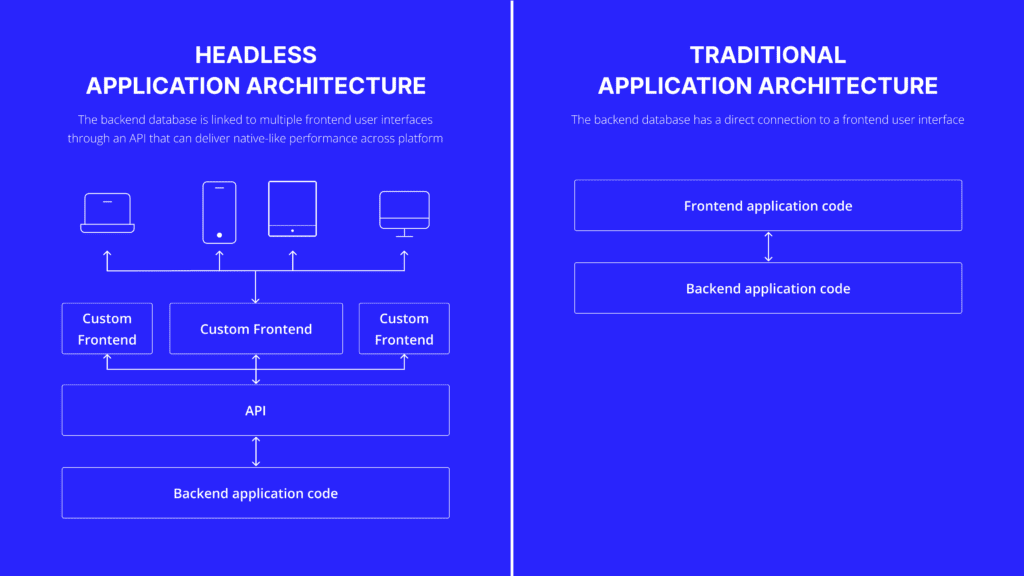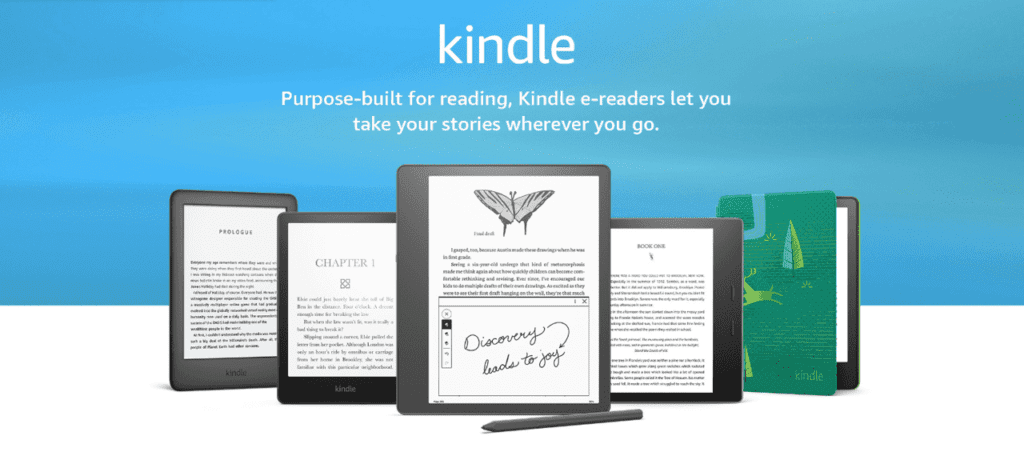What Is a Headless Application?
As odd as the phrase ‘headless application’ sounds, it’s actually highly descriptive.
When developers call an application headless, we’re referring to a database running without a typical frontend system – a functioning body without a head where developers can create multiple heads for one body.
Through headless application, developers have the flexibility to create multiple ‘heads’ or interfaces that interact with the same underlying data structure.
This decoupling of the frontend from the backend empowers developers to innovate and adapt more freely, enabling seamless integration with various platforms and enhancing scalability and agility in application design.”

Picture a physique with no head, only the ‘head’ is a front-end user facing interface like an app screen.

Defining characteristics of headless applications include:
- Seamless Data Exchange: Through robust APIs, headless architectures facilitate effortless data interchange, streamlining communication between backend systems and various endpoints.
- Omnichannel Content Delivery: In headless configurations, content dissemination transcends traditional boundaries. With a single backend serving as the content hub, information seamlessly flows to diverse frontends, including websites, mobile applications, smartwatches, IoT devices, and beyond. This omnichannel approach ensures consistent and personalized user experiences across a multitude of platforms, enhancing engagement and accessibility.
In this post, we’ll cover everything a non technical founder needs to know about headless applications – if that’s you, you’re lucky because it’s really not that much!
Key Headless Software Terminology
When delving into the world of headless applications, several key terms will keep cropping up, which we’ve summarized in the table below.
| Term | Definition |
| Traditional CMS | Like a box of pre-made Lego toys. Templates are provided, limiting flexibility but making it easier to start. |
| Headless CMS | Organizes content without specifying its appearance, like organizing Lego blocks without building a specific toy. |
| Headless API | Provides a link for computers to exchange data without seeing each other, facilitating data sharing without concerns about interface appearance. |
| Microservices | Like slices of pizza, each with a different topping, working together to create a complete system. |
| Decoupling | In software, it means separating parts of a system to change or update them without affecting the rest. |
| MACH Architecture | An acronym for Microservices-based, API-first, Cloud-native, and Headless. In practice, MACH refers to building customizable software with interchangeable parts, utilizing small, smart programs that communicate well and can be easily swapped, ensuring flexibility, speed, and readiness for upgrades. |
Now that you have a better understanding of headless software jargon, let’s dive into the topic properly.
Advantages of Headless Apps
Having a backend that isn’t tied to a specific front-end offers multiple benefits to both developers and founders:
- Design Flexibility: Decoupling the frontend from the backend allows for more flexibility in designing user interfaces, as developers are not restricted by the limitations of a traditional CMS.
- Improved Performance: Headless applications often have faster load times and improved performance since they only deliver essential content and resources, reducing overhead.
- Omnichannel Content Delivery: Content can be easily delivered to various channels and devices, enabling seamless experiences across web, mobile, IoT, and other platforms.
- Enhanced Security: Separating the frontend and backend reduces the attack surface, making it more difficult for attackers to exploit vulnerabilities in the application.
- Superior Scalability: Headless architectures are inherently scalable, allowing organizations to handle increased traffic and data volume by distributing resources efficiently.
- Technology Agnostic: Developers have the freedom to choose the best technologies for each component of the application stack, promoting innovation and the adoption of cutting-edge tools.
- Improved Developer Experience: Separating concerns between frontend and backend development streamlines the development process, enabling teams to work independently and iterate more rapidly.
Disadvantages of Headless Apps
As beneficial and widespread as headless applications are, they have their potential drawbacks compared to integrated solutions.
- Complexity in Development: Headless applications may demand more expertise to set up and maintain as developers need to manage multiple services and integrations.
- Increased Development Time: Separating the frontend and backend can lead to longer development cycles, especially if there are challenges in integrating with third-party services.
- Dependency on APIs: Headless applications are vulnerable to disruptions if APIs are updated or changed without proper backward compatibility.
- Learning Curve: Adopting a headless approach may require developers to learn new technologies, which can be challenging for teams accustomed to working with monolithic platforms.
- Potential Performance Overhead: The increased number of API calls and network requests may introduce latency and overhead, especially in high-traffic environments.
- Fragmented Content Management: As creators need to use separate interfaces or tools to manage content across different channels, content management can become disorganized,
- Vendor Lock-in: Depending on the headless CMS or services chosen, organizations may be restricted from switching to alternative solutions or migrating to different platforms in the future.
- Cost Considerations: A headless architecture may incur higher costs, including expenses related to infrastructure, development resources, and ongoing support, compared to monolithic solutions.
It should be noted that despite these drawbacks, developers continue to embrace headless applications because they offer significant advantages in flexibility, scalability, and future-proofing.
Examples of Headless Apps and Use Cases
Consider some real-world instances of headless apps for a myriad of uses, from content management systems to e-commerce platforms, website-building tools, and more.
| Industry/Application | Headless Applications/Architectures |
| Content Management Systems | – Contentful- Strapi- Sanity- Kentico Kontent- GraphCMS |
| E-commerce Platforms | – Shopify Plus- BigCommerce- commercetools- Elastic Path- Reaction Commerce |
| Digital Experience Platforms | – Acquia- Bloomreach- Core dna- Contentstack- Amplience |
| IoT and Smart Devices | – Particle.io- Losant- AWS IoT Core- Azure IoT Hub- Google Cloud IoT Core |
| Mobile App Development | – Firebase (with Firestore)- AWS Mobile Hub- Backendless- Kinvey- Kuzzle |
| Web Application Frameworks | – Next.js- Nuxt.js- Gatsby- Vue Storefront- Sapper |
| Digital Asset Management | – Bynder- Cloudinary- Widen- MediaValet- Canto |
| Headless Commerce Solutions | – Adobe Commerce Cloud (Magento)- Moltin- Reaction Commerce- Elastic Path- Slatwall Commerce |
| Marketing Automation Platforms | – HubSpot CMS Hub- Marketo Engage- Pardot- Eloqua- Act-On |
| Enterprise Resource Planning (ERP) Systems | – SAP S/4HANA- Oracle NetSuite- Microsoft Dynamics 365- Sage Intacct- Infor CloudSuite |
Speaking from personal experience, the Upstack Studio team has nothing but good things to say about Sharetribe’s headless ecommerce solution in ourlist of top no code web app builders.
We’ve found it offers flexibility and scalability without the usual drawbacks of headless solutions and it’s one of our favourite for building marketplace apps.

Should YOU Go Headless?
If you value flexibility and scalability, and don’t mind allowing your developers to learn new technologies on-the-fly, then headless applications provide a promising route.
Ultimately, it’s a question only you can answer, but we can help you with our headless application suitability checklist!
Headless Application Suitability Checklist
- Scalability Needs:
- Does your application need to handle high traffic volumes or rapid growth?
- Are you planning to expand to multiple channels or devices in the future?
- Flexibility Requirements:
- Do you require a high degree of customization and control over the user experience?
- Are you looking to integrate with various third-party services or APIs?
- Content Management Complexity:
- Do you have complex content structures that need to be managed across multiple platforms?
- Are you willing to invest in a separate content management system (CMS) or content infrastructure?
- Development Resources:
- Do you have a skilled development team capable of working with decoupled architectures?
- Are you prepared for potential learning curves associated with new technologies or paradigms?
- Performance Considerations:
- Is performance critical for your application, especially in terms of page load times and responsiveness?
- Can you manage potential performance overhead associated with increased API calls and network requests?
- Budget and Costs:
- Are you prepared for potential higher initial setup costs compared to traditional monolithic architectures?
- Do you have the budget for ongoing maintenance, infrastructure, and support expenses?
- Vendor Lock-in Concerns:
- Are you comfortable with potential vendor lock-in associated with specific headless CMS or service providers?
- Do you have a strategy in place for mitigating vendor dependency or switching providers if needed?
- Future-Proofing Considerations:
- Are you looking for a solution that can adapt to future technological advancements and industry trends?
- Do you prioritize long-term flexibility and scalability over short-term convenience?
- User Experience Goals:
- Do you aim to deliver consistent and personalized user experiences across various channels and devices?
- Are you willing to invest in frontend development to ensure seamless integration and user interactions?
- Competitive Advantage:
- Do you see headless architecture as a strategic advantage in differentiating your product or service offerings?
- Are you willing to invest time and resources in leveraging the benefits of headless applications to stay ahead of competitors?
If you answered ‘yes’ to these questions, headless architecture aligns with your business goals, and it sounds like there’s a strong argument for you to use one.
Conclusion: Headless Development Is Here to Stay
In conclusion, headless applications present a proven and viable solution for founders to consider.

The decision to work with headless apps ultimately depends on your business’s specific requirements, your team’s skills, and the vision for your product.
Hey there stranger, thanks for reading all the way to the end. Consider joining our mailing list for a one-stop resource on everything from micro SaaS validation all the way to execution and promotion. Get a nifty list of questions to ask app developers when you sign up!
Download this template now so you know exactly what to ask App Development Agencies! Let us know where should we send it through the form below.






